PHOTO YODOBASHI
YODOBASHI CAMERA ONLINE PHOTO MAGAZINE

SONY RX1R II / SHOOTING REPORT
We waited long enough for the "RX1RII," the successor of SONY’s full frame fixed-lens camera RX1/RX1R!
I don’t need to re-emphasize the high quality of the RX1 now because its market price has remained almost unchanged for three years since it was released. The small body is filled with advanced mechanism and the image quality is irresistibly attractive. Every time you see the images taken by the camera, or every time you see someone using it, you wanted to buy it someday. And, when two years have passed you postponed the decision until the next model is released. Now that the successor has finally appeared, your headache goes to the next stage. Will you go for the latest model? Will you venture to get the previous model? Will you replace it with the new model? Or, will you buy the new model keeping the previous one? Well, you may be able to make decision after checking the following images.
( Photography : A.Inden / Text : Guzzi )

No more battle over the necessity of low-pass filter?
The key evolution achieved by this model is the new 42.2-megapixel 35mm full frame sensor "Exmor R," which gathers significantly more information. While advanced technologies are essential to deliver light to the increased micro pixels, we’re most interested in the world’s first "optical variable low pass filter" which lets you control the effect of low-pass filter (hereafter, LPF). In other words, the new model is a combination of the RX1 with a LPF and the RX1R without it. Although more cameras don’t have LPFs in pursuit of higher resolution, it doesn’t mean they are unnecessary. This model lets you use the LPF in a situation where false color reproduction and moire can occur. Meanwhile, you can turn it off in a regular situation. This solution offered by SONY is nothing but marvelous.

I knew it’s unusual for Photo Yodobashi, but I took comparison shots using a tripod.
Starting from the left, the first one was shot without using the LPF. The second one was shot with a LPF standard setting. The third one was shot with a LPF strong setting. They are cropped images of the center of the original images which you can view by clicking. As expected, the image shot without using the LPF looks sharpest. Because of this result, I decided to turn the LPF off basically and turn it on whenever it’s necessary.

This rich rendition, realized by the bright F2 lens and the 35mm full frame sensor, bolsters the reputation of this camera. And, the definition achieved by the increased pixels is undeniably high. The layers and depth of the leaves are so realistic as if they were right in front of my eyes.

If shot with other cameras, subjects like moss could look more flat. This wonderful rendition is realized by the camera’s ability to capture the great detail including the wet air of the forest. All shots in this report, by the way, are JPEG images straight out of the camera.

With this camera, you’ll even want to shoot the ordinary scenes that you had been overlooking before, or the plants and flowers that you didn’t know their names. If you hold it tight and shoot, you’ll be rewarded with the superb image quality. You’ll have the same sensation you had when you were amazed by the rendition of a medium/large format. Remember when you pressed the shutter carefully after the wind stopped blowing? Back then, you perceived even trivial elements such as subject-shaking and airflow had a big impact on image.


The body, which was already well-designed since the RX1, facilitates shooting. The major mechanical evolution of this camera is the built-in retractable EVF which can be slid down when not in use. If you are interested in this camera, you want to shoot at eye-level.

Impressive reproduction of the texture. When a camera shoots an image like this, you can shoot almost anything with it. Instead of making a big deal of using a big camera, grab the RX1RII out of the pocket and shoot. You’ll look elegant even to non-photographers.

The macro mode has become even more convenient thanks to the EVF and the tilting rear LCD monitor. Almost no other compact cameras can take better table photography than this one.


High sensitivity performance is excellent as well. If we can use ISO 3200 with an F2 lens, you’ll have no trouble in shooting with available light. While a bamboo forest is a difficult subject even if it were shot in the daytime, the camera expressed it in such a great detail.

Let’s compare the shot at ISO 3200 (left) with the one at ISO 12800 (right). While the edges and detail of subjects tend to be lost at higher sensitivity, you’ll have no problem in viewing them at regular size. Anyway, this quality was impossible to realize in the past and it offers more flexibility in shooting.







Strikingly smart. Strikingly powerful.
The RX1 was a compact camera that takes strikingly excellent images, and the RX1RII inherits the appeal with latest technologies. The functionality is equivalent to the A7RII and it can even outperform the main cameras of many people. Of course, it’s nonsense to compare this camera with interchangeable-lens cameras whose use is different. Yet, with this numbers of pixels, you can get excellent image quality even after cropping and this way you can pretty much cover most scenes. In this sense, you don’t have to worry about having a fixed-focal 35mm lens. As a result, your headache grows because of this model…
The decisive moment doesn’t wait until you get a camera. The sooner you get it, the more you can enjoy it.
Wait. Maybe your headache is caused by something else, just like mine…
( 21.02.2016 )


